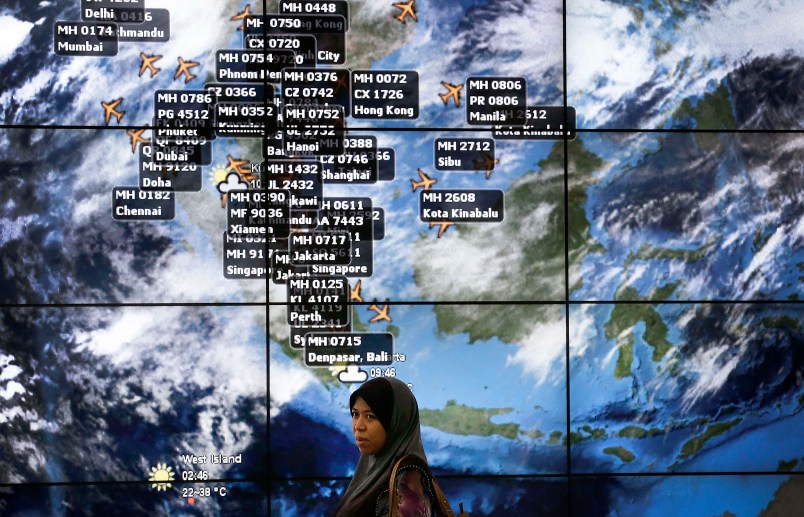KUALA LUMPUR, Malaysia (AP) — Search planes flying deep into the southern Indian Ocean have found nothing so far that could be from the missing Malaysia Airlines jet, Australia’s acting prime minister said Friday.
The planes are part of an international effort to solve the nearly 2-week-old mystery of what happened to Flight 370 with 239 people aboard. They are looking for two large floating objects detected by a satellite off the southwest coast of Australia, about halfway to the desolate islands of the Antarctic.
“The last report I have is that nothing of particular significance has been identified in the search today but the work will continue,” said Warren Truss, who is acting prime minister while Tony Abbott is in Papua New Guinea.
Truss said the search was difficult due to testing weather conditions and because the satellite imagery was five days old. “So something that was floating on the sea that long ago may no longer be floating — it may have slipped to the bottom. It’s also certain that any debris or other material would have moved a significant distance over that time, potentially hundreds of kilometers.”
Truss told reporters that two Chinese aircraft are expected to arrive in Perth on Saturday to join the search, and two Japanese aircraft will be arriving Sunday. A small flotilla of ships coming to Australia from China was still several days away.
“We are doing all that we can, devoting all the resources we can and we will not give up until all of the options have been exhausted,” Truss said. “We can’t be certain that the sightings are in fact debris from the aircraft (but) it is about the only lead that is around at the present time.”
The search area in the southern Indian Ocean is so remote is takes aircraft four hours to fly there and four hours back, leaving them only about two hours to search.
Four of the five search planes sent out Friday had returned to Perth, said Lisa Martin, spokeswoman for the Australian Maritime Safety Authority. The last plane, a U.S. P8 Poseidon aircraft, was expected back at 1100 GMT.
John Young, manager of the maritime safety authority’s emergency response division, said the weather had improved from Thursday, but there was still some low cloud cover over the search area, 2,300 kilometers (1,400 miles) from western Australia.
The aircraft are planning to head back to the search zone on Saturday, but the search area will change slightly depending on water movements overnight, Young said.
Abbott spoke with Chinese President Xi Jinping, whom he described as “devastated.” Of the 227 passengers on the missing flight, 154 were from China.
“It’s about the most inaccessible spot that you could imagine on the face of the Earth, but if there is anything down there we will find it. We owe it to the families of those people to do no less,” Abbott said.
The satellite discovery raised new hopes of finding the jet and sent another emotional jolt to the families of the people on board. The anguished relatives have been critical of Malaysian officials for delays in releasing information.
In Beijing, relatives met Friday with Malaysian officials at a hotel where most have been staying awaiting the latest news. Attendees said they had a two-hour briefing about the search but that nothing new was said.
One of the floating objects detected by the satellite was 24 meters (almost 80 feet) long and the other was 5 meters (15 feet).
The Norwegian cargo vessel Hoegh St. Petersburg is also in the area and its crew of 20 Filipinos is helping with the search. The ship, which transports cars, was on its way from South Africa to Australia. The Australian Maritime Safety Authority said another commercial ship and an Australian navy vessel were also en route to the search area.
Three Chinese naval ships were heading to the area, along with the icebreaker Snow Dragon, Chinese state television reported. The icebreaker was in Perth following a voyage to the Antarctica in January.
The planes are using radar to detect objects and then making low passes over the ocean to identify them visually because when “radar blips come back it’s not always clear what the object is,” said Michael Smart, an aerospace engineering professor at Australia’s University of Queensland.
“They use the radar to focus and then they go and visually look to see what it is,” he said. “The high technology and the low technology are equally important.”
The searchers face challenging weather conditions in an area known for its storms, he said. The planes’ radar detection capabilities can also be affected if objects are partially submerged as they bob in the ocean.
Smart predicted that “it will be just a matter of time before they are found.”
The hunt has encountered other false leads. Oil slicks that were seen did not contain jet fuel. A yellow object thought to be from the plane turned out to be sea trash. Chinese satellite images showed possible debris, but nothing was found.
Malaysian authorities have not ruled out any possible explanation for what happened to the jet, but have said the evidence so far suggests it was deliberately turned back across Malaysia to the Strait of Malacca, with its communications systems disabled. They are unsure what happened next.
Police are considering the possibility of hijacking, sabotage, terrorism or issues related to the mental health of the pilots or anyone else on board.
___
Gelineau reported from Sydney, Australia. Associated Press writers Rod McGuirk and Todd Pitman in Kuala Lumpur; Nick Perry in Wellington, New Zealand; and Christopher Bodeen in Beijing contributed to this report.
Copyright 2014 The Associated Press. All rights reserved. This material may not be published, broadcast, rewritten or redistributed.






